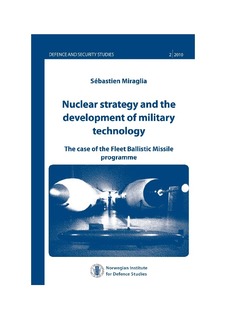| dc.contributor.author | Miraglia, Sébastien | |
| dc.date.accessioned | 2011-02-20T11:42:30Z | |
| dc.date.available | 2011-02-20T11:42:30Z | |
| dc.date.issued | 2010 | |
| dc.identifier.isbn | 978-82-91571-13-3 | |
| dc.identifier.uri | http://hdl.handle.net/11250/99269 | |
| dc.description | Nuclear weapons technology has a critical impact on international security. Nevertheless, the development of military technology requires a level of technical expertise that often prevents civilian authorities from directly controlling research and development activities. Using the Fleet Ballistic Missile programme of the US Navy as a case study, Sébastien Miraglia explores how military organisations transform declaratory policies and nuclear strategies into engineering problems.
This study unveils the conditions under which political control over nuclear technology may be secured, or lost. Based on recently declassified documents and interview transcripts of decisive actors, it also provides valuable insights on contemporary nuclear weapons issues. What are the origins of key technologies used by current and forthcoming nuclear weapons systems? To what extent should political leaders intervene in the selection of technical solutions? And, how does the relation between new strategies and aging technologies evolve over time? | en_US |
| dc.language.iso | eng | en_US |
| dc.publisher | Norwegian Institute for Defence Studies | en_US |
| dc.relation.ispartofseries | Defence and security studies;2 | |
| dc.subject | Atomvåpen | en_US |
| dc.subject | Kjernefysiske våpen | en_US |
| dc.subject | Forsvarspolitikk | en_US |
| dc.subject | US Navy | en_US |
| dc.subject | USA | en_US |
| dc.subject | Kalde krigen | en_US |
| dc.title | Nuclear strategy and the development of military technology: the case of the Fleet Ballistic Missile programme | en_US |
| dc.type | Non-fiction monograph | |
| dc.source.pagenumber | 127 | en_US |
